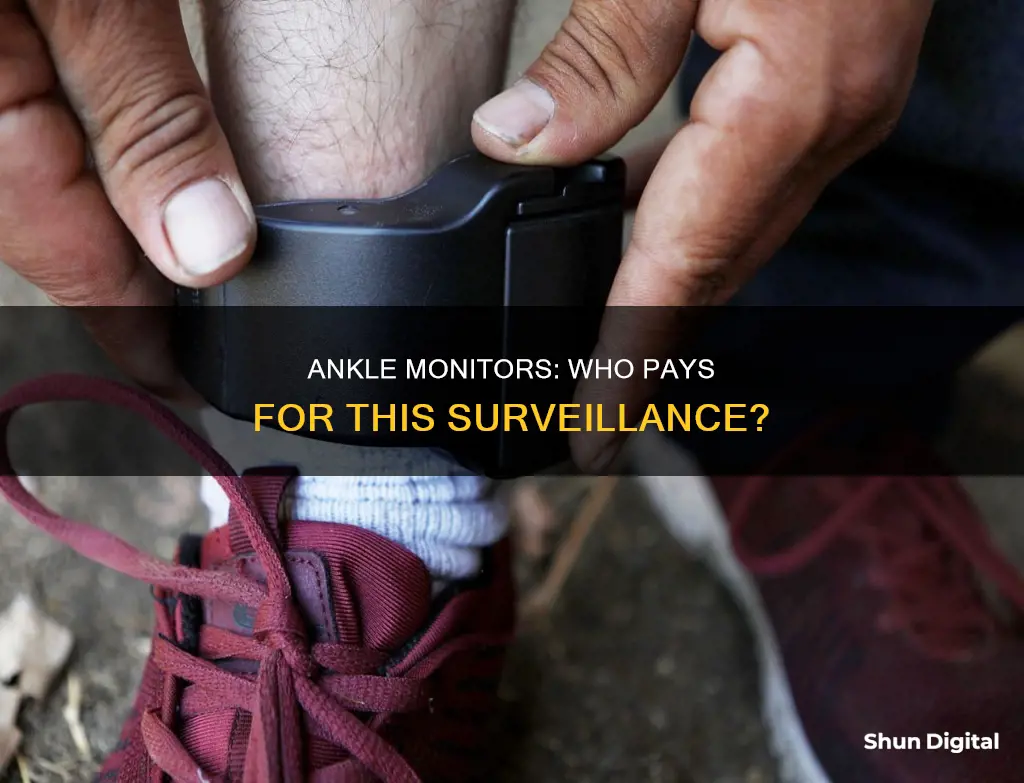
Ankle monitors are worn by defendants awaiting trial or convicted criminals serving their sentences outside of jail. In the US, the use of ankle monitors has been on the rise as part of bail reform. While they are promoted as a humane alternative to jail, ankle monitors are often costly, with fees imposed on the wearer. In most states, the individual is required to pay daily, weekly, or monthly fees, or a flat rate for their ankle monitor. These fees can be a financial burden, especially for those who cannot afford bail. In some cases, failure to pay the fees for an ankle monitor can result in extended supervision, additional fees, or even jail time. While some states have eliminated the electronic monitoring fee, the majority of states still require at least a partial payment from the wearer.
What You'll Learn
- Private companies charge hundreds of dollars a month for ankle monitors
- Ankle monitors are a cheaper alternative to jail for local governments
- People often have to pay for their own ankle monitors, even if they are innocent
- Failure to pay for an ankle monitor can result in extended supervision, additional fees, or jail time
- In 2022, California passed legislation expressly prohibiting the use of ankle monitor fees

Private companies charge hundreds of dollars a month for ankle monitors
Private companies are profiting from the growing use of ankle monitors, charging hundreds of dollars a month for their use. This has raised troubling questions about discrimination on the basis of race and poverty.
In the US, half a million people are jailed without conviction because they cannot afford to pay bail. Bail reform has led to the increased use of ankle monitors for pre-trial defendants. In 2015, more than 125,000 people were supervised with electronic monitors, compared to 53,000 in 2005. This number is likely to continue to rise.
Many jurisdictions outsource electronic monitoring programs to private companies, for whom "community corrections" services are among the fastest-growing revenue sectors. These companies set their own rates and charge interest when payments are missed.
In St. Louis, for example, the private monitoring company Emass charges defendants $10 a day for monitoring services. This is significantly more than the $2 to $3 per day that cities typically pay private contractors for the same equipment and services.
The high cost of ankle monitors often puts poor people in a difficult position. Defendants who have not been convicted of a crime are put on "offender-funded" payment plans that can cost more than bail. If they cannot keep up with payments, they risk being sent back to jail, even if they are later found innocent.
In addition to the financial burden, ankle monitors can make it difficult for individuals to find and keep a job. The devices are bulky and require weekly check-ins with the monitoring company. A 2011 survey by the National Institute of Justice found that 22% of people on electronic monitors had been fired or asked to leave a job because of the device.
The use of ankle monitors by private companies, therefore, raises serious concerns about the financial and social impact on individuals who are often already in a vulnerable position.
Choosing the Right Desk for Your Triple Monitor Setup
You may want to see also

Ankle monitors are a cheaper alternative to jail for local governments
For local governments, ankle monitors can be a more cost-effective option than incarceration. In the United States, the cost of incarcerating individuals has soared, reaching $87 billion in 2015, up from $19 billion in 1980. By contrast, the daily cost of monitoring an individual through an ankle monitor is significantly lower, and this cost is often passed on to the individual wearing the device. This can result in substantial savings for local governments, especially when compared to the cost of detention.
In St. Louis, for example, it costs the city approximately $90 a day to detain a person awaiting trial. By using ankle monitors, the city can pass on the cost of supervision to the individual, which can be as low as $2 to $3 a day. This not only saves the city money but also allows them to avoid the financial burden of jail overcrowding.
However, passing the cost of ankle monitors to individuals can create a cycle of poverty and debt. The set-up fee for these devices can be between $175 and $200, with daily fees ranging from $5 to $40. For individuals who are already struggling financially, these fees can be exorbitant and can lead to unemployment and debt. In some cases, individuals may even plead guilty to reduce the time they have to wear the monitor and the associated costs.
While ankle monitors can be a cheaper alternative to jail for local governments, it is important to consider the financial burden they place on individuals. The high cost of these devices can create significant financial hardship and may even deter people from seeking employment or socialising due to the stigma and inconvenience of charging the device. Therefore, while ankle monitors may save local governments money, they can have a significant impact on the individuals who are required to wear them.
Enabling 165Hz on Your ASUS Monitor: A Step-by-Step Guide
You may want to see also

People often have to pay for their own ankle monitors, even if they are innocent
However, this cost-saving measure for the state often comes at a high price for the individual, who is typically required to pay for the cost of the monitor and a daily use fee. These fees can be extremely burdensome, with private companies charging defendants hundreds of dollars a month to wear the surveillance devices. In some cases, individuals may be charged a flat fee of about $5-15 per day, plus a setup fee as high as $200. For those who cannot afford these fees, the alternative may be jail.
The financial burden of ankle monitors is further exacerbated by the fact that individuals are often required to pay these fees even if they are found innocent. This means that, in addition to the stress and uncertainty of facing criminal charges, individuals must also bear the financial cost of their own surveillance.
While ankle monitors are promoted as a humane alternative to jail, the high cost of these devices can create significant financial hardship for those who are required to wear them. This is especially true for individuals who are already struggling financially or who have limited job prospects due to their criminal record.
Furthermore, the use of ankle monitors can also have negative psychological effects, with many people reporting feelings of entrapment and constant surveillance. The stigma associated with wearing an ankle monitor can also make it difficult to find employment, which further compounds the financial burden for those who are already struggling to pay the fees associated with their monitoring.
Overall, while ankle monitors may be presented as a cost-saving alternative to incarceration, the reality is that the cost is often shifted from the state to the individual, who may be innocent and yet still burdened with significant financial and psychological consequences.
Best 1440p Monitors: Elevate Your Viewing Experience
You may want to see also

Failure to pay for an ankle monitor can result in extended supervision, additional fees, or jail time
Ankle monitors are often used as an alternative to pre-trial detention or as a condition of probation. They are usually employed for people who are considered a danger to the community or a flight risk. While they allow individuals to remain free while awaiting trial, they come at a cost. In most states, the person wearing the ankle monitor is responsible for paying daily, weekly, or monthly fees for their tracking and monitoring.
The consequences of not paying for an ankle monitor can be severe. Firstly, failure to pay the associated fees can result in extended supervision. This means that the individual may be subjected to additional monitoring and restrictions on their movement for a longer period. Secondly, additional fees may be imposed, further increasing the financial burden. Finally, and most seriously, non-payment can result in jail time. This defeats the purpose of the ankle monitor, which is to provide an alternative to incarceration.
The fees associated with ankle monitors can be a significant financial burden, especially for those who are already struggling financially. In some cases, individuals may have to choose between paying for the ankle monitor and providing for their basic needs or their family's needs. This can create a cycle of debt and punishment that is difficult to escape.
While some argue that the individual should bear the cost of the ankle monitor as a consequence of their actions, others argue that this is an unfair exploitation of those who are already at a disadvantage. The profit motive of private companies involved in the ankle monitoring business further complicates the issue.
The consequences of non-payment can further entangle individuals in the criminal justice system, leading to extended supervision, increased fees, or even jail time. This can create a cycle of punishment and financial hardship that makes it challenging for individuals to reintegrate into society and become law-abiding citizens.
Monitor Bugs: ASUS Warranty Coverage Explained
You may want to see also

In 2022, California passed legislation expressly prohibiting the use of ankle monitor fees
In the United States, ankle monitors, also known as electronic monitoring devices (EMDs), are often used as an alternative to incarceration in the criminal justice system. These devices are typically attached to an offender's ankle, allowing law enforcement to monitor and track their location in real time. While EMDs serve as a tool to address prison overcrowding, their use comes with a range of fees that can be financially burdensome and challenging to quantify.
In most states, individuals on EMDs are required to pay daily, weekly, or monthly fees, or a flat rate, to be tracked and monitored. The cost of setting up electronic monitoring services typically ranges from $175 to $200, with daily fees ranging from $5 to $40. These charges can accumulate significantly for individuals who need to wear an ankle bracelet for extended periods or even lifetimes.
However, in a notable shift, California passed legislation in 2022 expressly prohibiting the use of fees for electronic monitoring. This move sets California apart from the majority of states that authorize and impose electronic monitoring fees, which can have detrimental consequences for those unable to pay.
The prohibition of electronic monitoring fees in California reflects a growing recognition of the financial strain these charges can place on individuals, particularly those who may already be facing economic challenges. By removing these fees, California is taking a step towards a more equitable justice system, ensuring that financial barriers do not exacerbate the difficulties faced by those involved with the criminal justice system.
While California has taken a lead in this area, it is one of only two states that expressly prohibit the use of EMD fees, indicating that more work needs to be done to address this issue nationwide.
Monitor Calibration: Identifying 6500K Color Temperature Perfection
You may want to see also
Frequently asked questions
In most states, individuals on electronic monitoring (EM) are required to pay daily, weekly, monthly, or flat fees. Private companies charge defendants hundreds of dollars a month to wear these devices.
Yes, in some cases, individuals may be able to secure funding through a nonprofit fund, such as the Bail Project, or through a court-established fund to help indigent defendants.
Failure to pay EM fees can result in extended supervision periods, additional fees, or even jail time. In some cases, private companies can initiate criminal court proceedings and threaten defendants with returning to jail.
Yes, Hawaii is the only state that does not require individuals to pay for GPS monitoring. However, it's important to note that EM fees have been eliminated in certain states like Missouri, but this may vary depending on the specific circumstances and local legislation.







